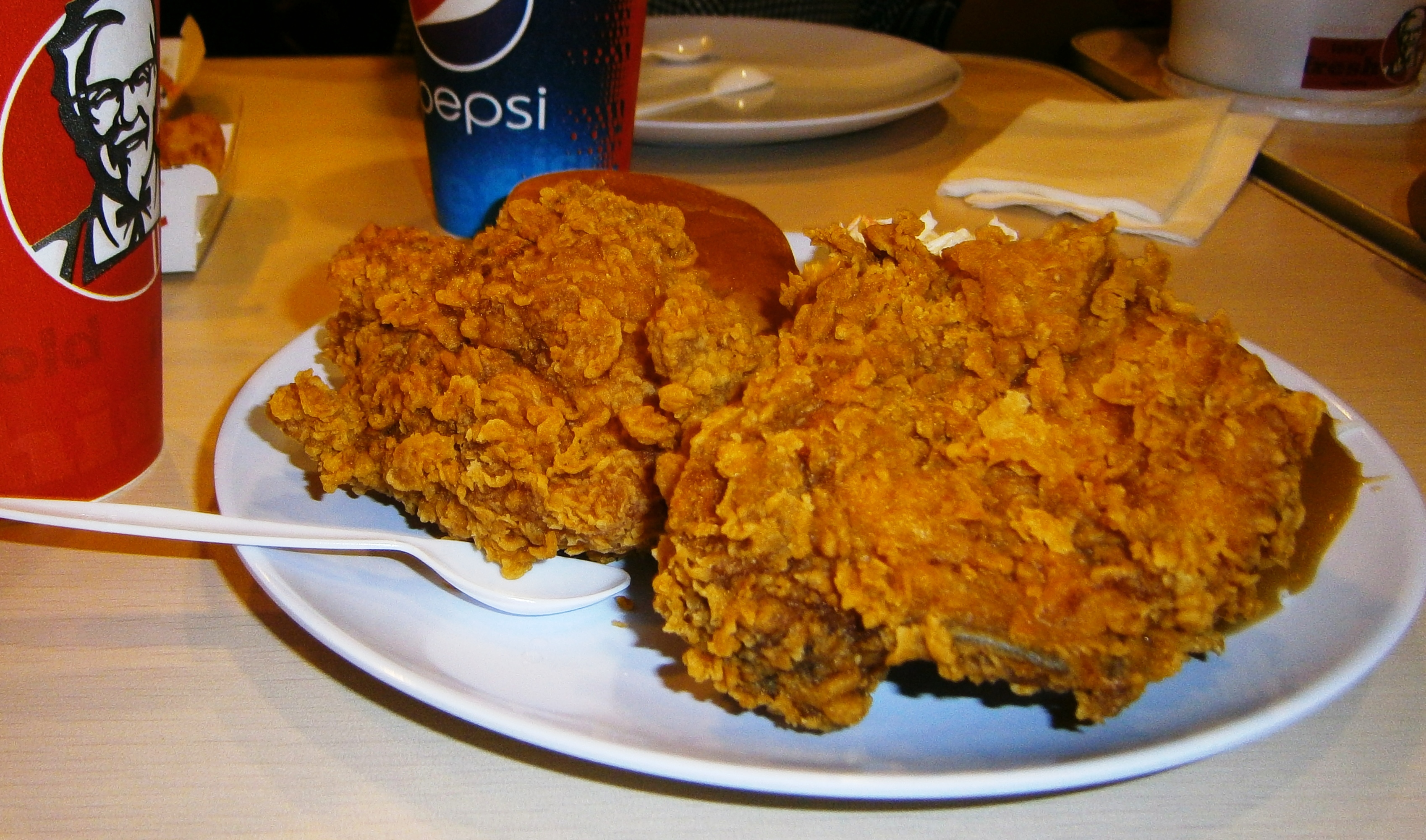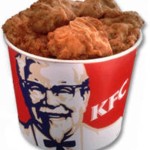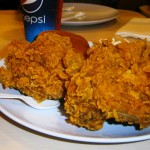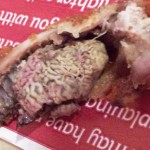Yes, another franchised global chain selling highly commoditised fast food, replete with its bold red branding and familiar logo, highly reminiscent of my review of McDonalds. So since I obviously don’t like mass-produced high-volume over-marketed fast foods , why yet another review? My son fancied KFC and would not stop talking about it, so KFC drive-thru it was, and a review inevitably to follow.
This is another company with a history mythologised to preserve any romance, so in case you fancy reading the carefully edited story of “Colonel” Harland Sanders, here it is. But the real corporate stuff comes in Wikipedia:
By 1963 there were 600 KFC restaurants, making the company the largest fast food operation in the United States. KFC popularized chicken in the fast food industry, diversifying the market by challenging the established dominance of the hamburger.
In 1964, Sanders sold the company to a group of investors led by John Y. Brown Jr. and Jack C. Massey for US$2 million (around US$15 million in 2013). The contract included a lifetime salary for Sanders and the agreement that he would be the company’s quality controller and trademark. The chain had reached 3,000 outlets in 48 different countries by 1970. In July 1971, Brown sold the company to the Connecticut-based Heublein, a packaged food and drinks corporation, for US$285 million (around US$1.6 billion in 2013). Sanders died in 1980, his promotional work making him a prominent figure in American cultural history. By the time of his death, there were an estimated 6,000 KFC outlets in 48 different countries worldwide, with $2 billion of sales annually.
In 1982, Heublein was acquired by R. J. Reynolds, the tobacco giant. In July 1986, Reynolds sold KFC to PepsiCo for $850 million (around US$1.8 billion in 2013). PepsiCo made the chain a part of its restaurants division alongside Pizza Hut and Taco Bell. The Chinese market was entered in November 1987, with an outlet in Beijing.
In 1991, the KFC name was officially adopted, although it was already widely known by that initialism. Kyle Craig, president of KFC US, admitted the change was an attempt to distance the chain from the unhealthy connotations of “fried”. The early 1990s saw a number of successful major products launched throughout the chain, including spicy “Hot Wings” (launched in 1990), popcorn chicken (1992), and internationally, the “Zinger”, a spicy chicken fillet burger (1993). By 1994, KFC had 5,149 outlets in the US, and 9,407 overall, with over 100,000 employees. In August 1997, PepsiCo spun off its restaurants division as a public company valued at US$4.5 billion (around US$6.5 billion in 2013). The new company was named Tricon Global Restaurants, and at the time had 30,000 outlets and annual sales of US$10 billion (around US$14 billion in 2013), making it second in the world only to McDonald’s. Tricon was renamed Yum! Brands in May 2002.
So then, a corporate football, a profit machine and a franchise network the world over flogging any meal you like, so long as it’s based on chicken. Yes, KFC is an exponent of variants of the traditional American delicacy, Southern Fried Chicken, which, unlike less user-friendly southern delicacies (grits, chitterlings, collard greens, neck bones, cornbread and suchlike) made for an easy market almost everywhere.
The thing is that chicken is almost a lowest common denominator, everyone who is not a veggie eats it, and it’s proven easy to commoditise, farm in mass production volumes, nail down costs to the tiniest fraction of a penny and provide fulfilment outlets everywhere. All well and good, but KFC has had several obstacles to overcome in its battle for market dominance alongside the burger giants:
- It’s easy to do, so everyone does it – lots of competition.
- In the past 30 years or so we’ve come to realise just how unhealthy deep fried food can be and therefore to choose lower fat options
- Concern over animal welfare standards means many people were turned off mass-produced chicken
No 1 was easy to the brand marketing boys, of whom these chains have many. They set up the USPs in the form of distinctive marketing, convenient locations and nice promotions that appealed to all the family, while essentially serving exactly the same formula and process as fast food giants everywhere – and in this case the mystique added was their “secret blend of 11 herbs and spices” which in practice is almost certainly stuff you use every day and therefore not especially a secret worth knowing. Their strap lines changed over time – “finger-lickin’ good” morphed into “so good ™”, but essentially the message was the same: ‘this is your favourite, so why try any other? You know you can depend on us to serve you exactly the same meal you had last time.’
Maybe the attraction is not the food but that Joe Public wants to be associated with the brand and doesn’t care who knows it, which would if true for the mainstream, be a very sad indictment of shallow modern values. Brands are to me nothing, they are worthless. The product is all that counts, and if the product is awful then you shouldn’t buy it. Brand loyalty is fine if it’s the product justifies it, otherwise it is a millstone around the neck of society.
Like McDonalds, KFC had its share of bad press to deal with along the way, not least the chicken brains that appeared in one diner’s dinner in Colchester (just up the road from me) and thereafter in many a newspaper article (no, I don’t believe for one second that it was kidney, that was a corporate whopper – no pun intended.) Frankly, their denial that it was brain matter was an insult to the intelligence of the general public, but it didn’t stop the growth of punters or profits. Clearly the power of marketing and commoditisation of our food has a major hold on the public.
The company has however taken the health and animal welfare messages seriously, with tweaks to the menu to cut the calorie content and offer salads without a stack of grease. In fact, tastes have changed over time such that a significant proportion of the population can’t abide eating meat or fish off the bone, where in the culture of times past that was part of the attraction. So nowadays we have a wide range of burgers (ie. the same soft, sweet buns adopted by burger chains) and boneless breast strips sitting alongside the traditional buckets of mixed chicken pieces (drumsticks, thighs, breast and wing) served on the bone. We also now have the “Zinger” range, incorporating our new favourite ingredient, namely chilli. There is the inevitable range of soft fizzy drinks, supplemented by juices, water, halfway decent coffee and a range of other family-friendly alternatives to the pots of liquid sugar and caffeine that send your kids hyper.
As for the chicken welfare, a whole menu on the company’s website is dedicated to myth busting and demonstrating their use of British farm standards and the highest levels of welfare and care, such that all their chickens live happy lives. I’d suggest many serious experts in the field could ask rather more searching questions than those printed on the website, but from my perspective you will never get the highest quality of flavour in a mass-produced environment. But for those who want to know, here is the reality according to KFC:
do you breed chickens with no heads
No! All our suppliers’ chickens have head, beaks, feathers, feet, and guaranteed welfare and quality standards which are the same all over the world.
I had watched a video of chickens being treated really badly and it looked really cruel, I hope that isn’t the case
It’s not. All our suppliers’ farms are carefully supervised and audited to make sure they meet acceptable standards of animal welfare. The chickens are kept free from hunger, disease and pain, and are humanely stunned before slaughter, which is continuously supervised by vets. We work with independent industry experts to develop our welfare programmes.
Is ur food made out of real authentic chickens? Because I have heard that some of the food ur make is from man made organisms, is this true?
Sounds creepy. We’re happy to confirm that, no, all our chicken is 100% real, authentic Grade-A chicken – the same as the chicken you buy in the supermarket and cook at home. Only slightly more delicious.
And so on… I suspect the real questions with evidence are suitably buried and the truth about the cheap and not-so-cheerful chickens probably remains buried along with their bones.
Anyway, back to Saturday’s visit. Problem no 1 is that the menu by the drive-thru speaker is slightly small print and resulted in a frustrated server when we took more than our allotted 10 seconds (or whatever it was) to choose from the menu. It was not obvious whether or not various combos came with our without fries, so in the end we took pot luck and ordered a “lunchbox” for Adam and a small tub of assorted chicken parts, plus two corn cob pieces.
Getting these home, it was evidently a good idea not to order extra fries since we had about half a dozen bags of lukewarm, soggy pommes allumettes (ie. long thin fries.) Adam assures me they were OK when microwaved, but I will take his word for that. The corn cob sections proved to be two lollipops, roughly a quarter of a cob each, stuck on the end of a wooden pole and covered in a plastic bag. This was evidently because they had been smothered in some form of spread or margarine to keep them moist, certainly not butter since it had no noticeable flavour, but the overall effect was slightly weird – soft corn with no demonstrable texture, tasting of precisely nothing, certainly not of corn. More like carpet underlay, if anything.
But what you want to know was about the chicken. Cooking chicken in this way (as per the link at the other end of this blog) is not difficult. The effect of the mixture added is to surround the chicken with a crumbly seasoning, which in frying protects the meat from drying out or absorbing more fat, not unlike the theory of batter on fried fish, in which the fish is poached inside the batter and stays moist, though the coating of KFC is for its devotees as much of an attraction as the chicken itself. I think it’s fair to say this theory works fine for drumsticks and thighs, but the breast pieces did seem dry and tasteless, irrespective of the coating.
Eating KFC chicken reminds me of the addictive quality of fried food but also that it is not inherently satisfying to eat. Three mouthfuls in and I wanted a drink. Another drumstick later and my mouth felt like a the bottom of a birdcage. I finally got through four pieces of chicken, a few fries, one piece of corn, and stopped there having enjoyed not a single solitary bite. Adam ate his but I can’t say either of us looked or felt any better for the experience, though he would probably tell you that he will look forward to going again – but not in the very near future.
The point about KFC and other Cathedrals to fast food is that they feed this addiction repetitively. People chew on the products for the sake of chewing. Brains notwithstanding, they get what they expect and are rarely disappointed, but it’s not food to elevate the spirit or satisfy the soul, nor to provide true flavours. Speed is of the essence, not savouring each mouthful, but you have to blame modern lifestyles for the fact that KFC and McDs are part of the rich tapestry of American imperialism, this not being a style of dining native to these shores. I wish we didn’t eat like that other than when there is little alternative, but it has its place.
My mission is to get us to rediscover the joy of fresh, local, seasonal ingredients and cooking them for ourselves and our families – and trust me, that is ultimately far more satisfying and doesn’t have to be time consuming or complicated! All I can tell you is this: I shall not be returning to any KFC unless there really is no sensible dining alternative.










I think you’ll find that a company has little control over the rate at which it’s product will retain or obtain moisture, especially when it’s been subjected to a 15 minute car journey.
Do they expect everyone ordering drive-thru to eat the goods in the car park then?
Not necessarily, I think the intention is that it can be eaten on the go, rather than used as a takeaway service
You can’t eat and drive, well not unless you want to crash and/or get arrested!!
Nor would I especially want the inside of my car to be coated in chicken grease, thank you very much!! Think you’ll find it is a takeaway service but that no reheating instructions are provided lol
The Kentucky farm chicken. That’d be the geneetically modified one with two dozen legs and a head the size of a pea?